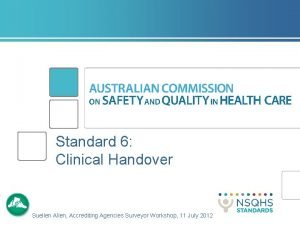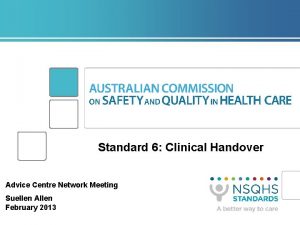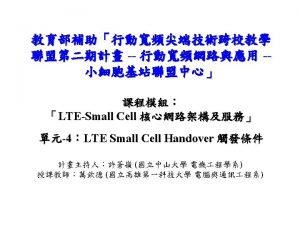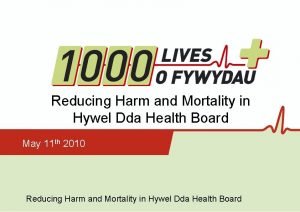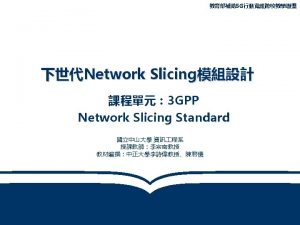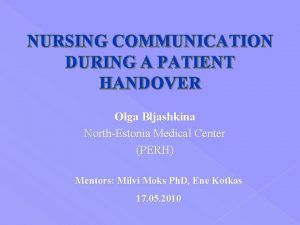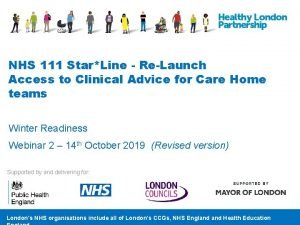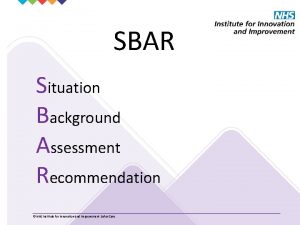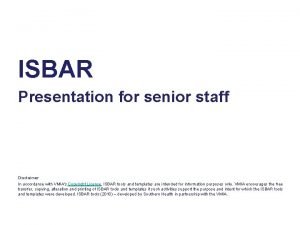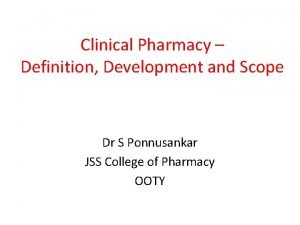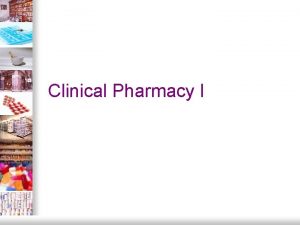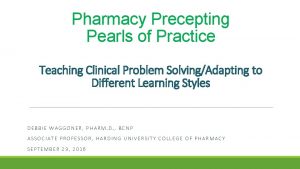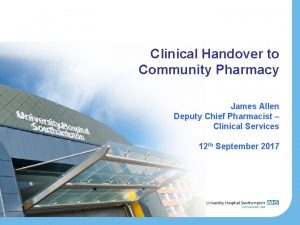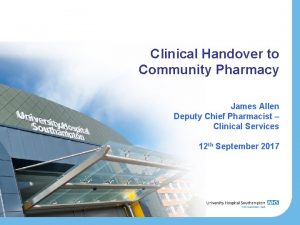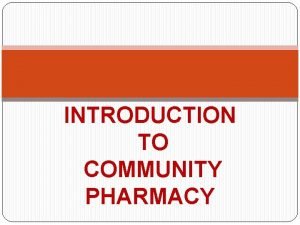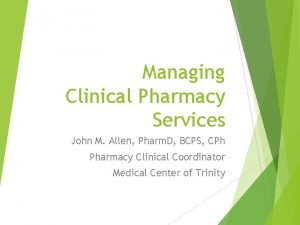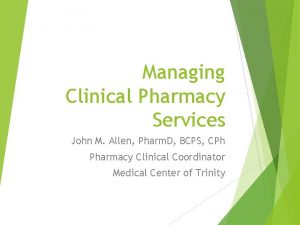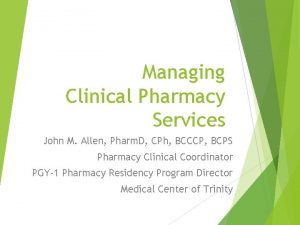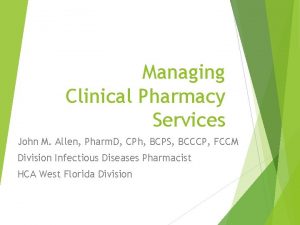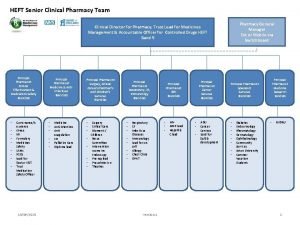Clinical Handover to Community Pharmacy James Allen Deputy
















- Slides: 16

Clinical Handover to Community Pharmacy James Allen Deputy Chief Pharmacist – Clinical Services 12 th September 2017

Scale of the problem • Only 16% of patients who are prescribed a new medicine take it as prescribed, experience no problems and receive as much information as they need(1). • Ten days after starting a medicine • Almost a third of patients are already non-adherent – of these • 55% don’t realise they are not taking their medicines correctly • 45% are intentionally non-adherent. • Pharmacist counselling in outpatients with chronic disease reduced mortality from 17% to 11% over 2 years (2) • Targeted pharmacist counselling has been shown to reduce readmission rates from 21. 6% to 15. 7%(3)

Meet Vera • • Average number of medicines = 9 Average number of changes = 4 Average length of stay = 4 days 4 out of 5 times discharge medicines and plan organised on day of discharge • Has around a 1 in 10 chance of re -admission


Further evidence of local need. . . • 342 patient / carer medicines helpline calls last quarter – 55% about appropriateness or safety of medicines – 38% about how to take medicines – 19% about getting further medicines supplies • UHS is not paid for re-admissions equalling an approx. cost ~£ 3 -4 million. – Based on Newcastle data local health economy saving = £ 1. 4 million

Discharge experience in the National Inpatient Survey UHS scored near the bottom end as the average performance. Of particular note is that patients felt: • They weren’t given enough support or information about what they should do or how to manage their condition (Q 59, Q 60, Q 61, Q 63, Q 66, Q 68) – all of these questions scored below 7/10 • Overall, UHS scored a 6. 8/10 for ‘Leaving Hospital’, suggesting from a patient perspective, we are not delivering a good standard of discharge that is response to their needs.

To consider: two major issues within discharge- underpinned by the same factor: communication UHS want to deliver a timely discharge, but they also want clear information about the process itself and about their condition and medications. Timeliness Information Process & system Patient education Communication Clarity and written Realism / expectations Effective Communication Positive patient experience Plain English Additional information: e. g. Contact numbers, how to change appointments Access to care for acute issues Guide for selfmanagment of conditions Access to expert advice

Who do we plan to refer • Patients that fit any of the following criteria – Patients with identified concordance/medicines management issues – 4 or more changes to their medicines – Multiple admissions with medicines supplies – Monitored dosage systems – Referred for monitored dosage system but rejected – New ‘high risk’ medicines (insulin, DOAC) – Special formulations / products – Smoking cessation, flu jab • Any patient that self refers or asks for service on admission during our ‘initial consent’

Case Study • Patient admitted with worsening heart failure • Switched to intravenous diuretics on admission • Aggressive diuresis results in signs of acute kidney injury • Ready for discharge but on lower doses of diuretic than on admission! • MDS tray required… • Needs a failsafe follow-up to ensure diuretics are escalated back to usual dose in 7 -10 days

How will a UHS referral look?

Referral reason / details

How do I deal with a referral?


Measuring the impact and future work • Working with LPC & CCGs to measure local impact – Raw numbers – Re-admissions – Interventions/success stories • Plan to share successes and learning at an event in late November.

Questions

References 1) Royal Pharmaceutical Society. Medicines Optimisation: Helping patients to make the most of medicines. 2013. 2) Wu JYF, Leung WYS, Chang S, Lee B, Zee B, Tong PCY, et al. Effectiveness of telephone counselling by a pharmacist in reducing mortality in patients receiving polypharmacy: randomised controlled trial. BMJ. 2006; 333(7567): 522. 3) Wilkinson T, S, Pal A, Choudry R, J, Impacting Readmission Rates and Patient Satisfaction Results of a Discharge Pharmacist Pilot Program. Hosp Pharm 2011; 46(11) 876 -883.
 Clinical handover standard 6
Clinical handover standard 6 Standard 6 clinical handover
Standard 6 clinical handover In allen wipfeln spürest du
In allen wipfeln spürest du Igbo
Igbo Lte event
Lte event Isbar example
Isbar example Sbar perawat
Sbar perawat Sbar handover
Sbar handover 5g pdu
5g pdu Sbar handover
Sbar handover Sbar handover
Sbar handover Nhs institute for innovation and improvement sbar
Nhs institute for innovation and improvement sbar Isbar presentation
Isbar presentation Now is the time to repent
Now is the time to repent Scope of clinical pharmacy in india
Scope of clinical pharmacy in india What are the objective of clinical pharmacy
What are the objective of clinical pharmacy Pharmacy practice pearls
Pharmacy practice pearls
